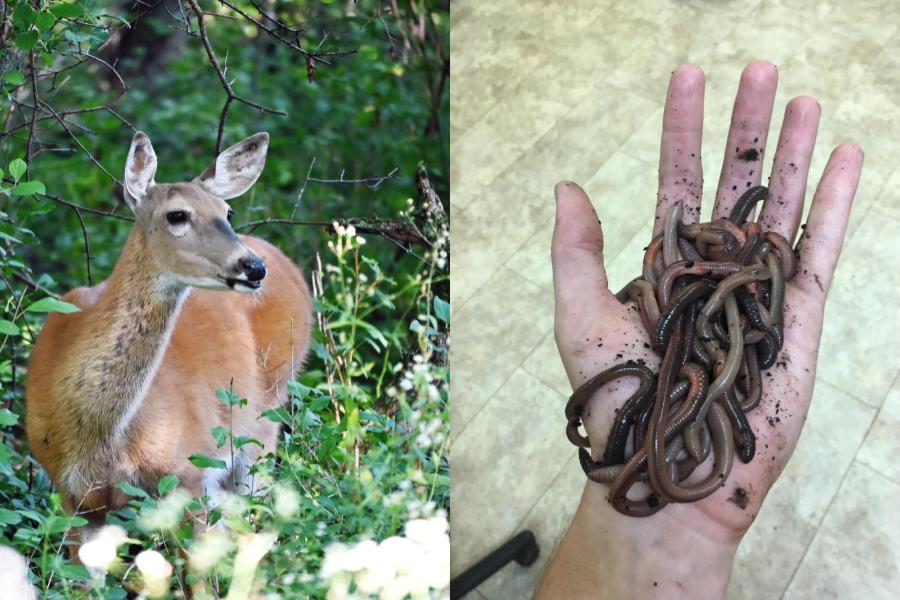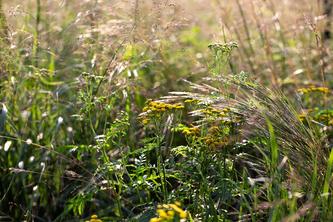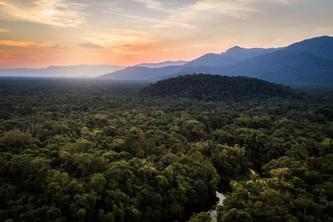
MINNEAPOLIS/ST. PAUL (04/18/2023) — There’s a surprising and highly influential link between invasive earthworms, white-tailed deer and tree harvesting in northern forests, according to new research from the University of Minnesota.
The findings, recently published open access in the journal Ecology, show invasive earthworm populations increase with deer presence and decrease with tree harvesting. Increased earthworm invasion is cause for concern because the species is known to harm soil and regenerating trees.
"Invasive earthworms are ecosystem engineers which negatively impact fundamental ecosystem properties such as nutrient retention and the diversity of native plant species. Deer exacerbate these negative impacts by increasing earthworm populations,” said Lee Frelich, an adjunct professor in the Department of Forest Resources and Director of the Center for Forest Ecology.
The team of U of M researchers, in collaboration with the U.S. Forest Service, the Wisconsin Department of Natural Resources and others, sampled earthworms in two long-term experiments in northern Wisconsin. Both experiment sites were established in the mid-2000s and simulated deer exclosures and tree harvesting — which leaves behind a large canopy gap in the overstory.
Nearly 13 years after each experiment started, the team tested how the deer exclosures and the tree canopy gaps impacted earthworm populations. The researchers also used earthworm data collected prior to the experiment’s establishment to test how earthworms changed over 13 years. Earthworms were sampled by pouring a slurry of mustard powder and water on the ground, which causes earthworms to come shooting to the surface — a method anyone can use at home.
The researchers found:
- In both experiments, invasive earthworms were lowest in areas where there were no deer and with a canopy gap overhead.
- In addition, earthworms increased the most over 13 years in areas outside of deer fencing and far away from the center of canopy gaps.
- The largest and most influential earthworm species were increased by deer and decreased by canopy gaps.
These findings suggest reducing deer populations may be one management strategy to slow earthworm invasion. In situations where it is not possible to reduce deer populations, creating mid-sized canopy gaps might be another strategy to slow the invasion.
“Capitalizing on the links between disturbances may be a real solution to safeguard ecosystems, as controlling one disturbance can indirectly reduce the severity of another. However, we have to figure out which disturbances are linked in the first place, highlighting the need for more multi-disturbance research,” said lead author Sam Reed, a Ph.D. student in the College of Food, Agricultural and Natural Resource Sciences.
The research team has several theories as to how these disturbances might be linked. First, deer could be changing the soil in a way that is favorable for earthworms, through fecal and urinary waste. Another theory is that since deer voraciously consume and kill flora, plants could be reallocating nutrients below ground to their root systems to avoid being eaten, which could indirectly favor earthworms. When it comes to tree harvesting and canopy gaps, researchers theorize canopy gaps could decrease earthworm populations because there is less moist, high-nutrient leaf litter underneath a canopy gap, which earthworms use for food and shelter.
Future research is needed to focus on the mechanisms behind how deer and tree harvesting might change invasive earthworm populations. In addition, disturbance ecology as a whole should be broadly testing how disturbances might be influencing one another and how ecosystems respond to multiple, overlapping disturbances.
About the College of Food, Agricultural and Natural Resource Sciences
The University of Minnesota’s College of Food, Agricultural and Natural Resource Sciences (CFANS) strives to inspire minds, nourish people, and sustainably enhance the natural environment. CFANS has a legacy of innovation, bringing discoveries to life through science and educating the next generation of leaders. Every day, students, faculty, and researchers use science to address the grand challenges of the world today and in the future. CFANS offers an unparalleled expanse of experiential learning opportunities for students and the community, with 12 academic departments, 10 research and outreach centers across the state, the Minnesota Landscape Arboretum, the Bell Museum of Natural History, and dozens of interdisciplinary centers. Learn more at cfans.umn.edu.
- Categories:
- Agriculture and Environment





